MA611 Auditing Report: A Comparative Study of PwC and Pitcher Partners
VerifiedAdded on 2023/06/11
|8
|2540
|391
Report
AI Summary
This report provides a comparative analysis of two accounting firms, PwC and Pitcher Partners in Australia, examining their services, geographical coverage, staff size, industry expertise, publications, marketing messages, missions, and profit margins. PwC is a global firm with extensive resources and a broad range of services, while Pitcher Partners focuses on the Australian market with a more personalized approach. The report also discusses the reasons for choosing Pitcher Partners as a preferred firm for professional growth, citing its smaller size and opportunities for greater involvement in decision-making. Additionally, the report touches on the agency theory and information hypothesis in the context of the Arthur Andersen collapse, highlighting the importance of trust and accurate information in auditing.
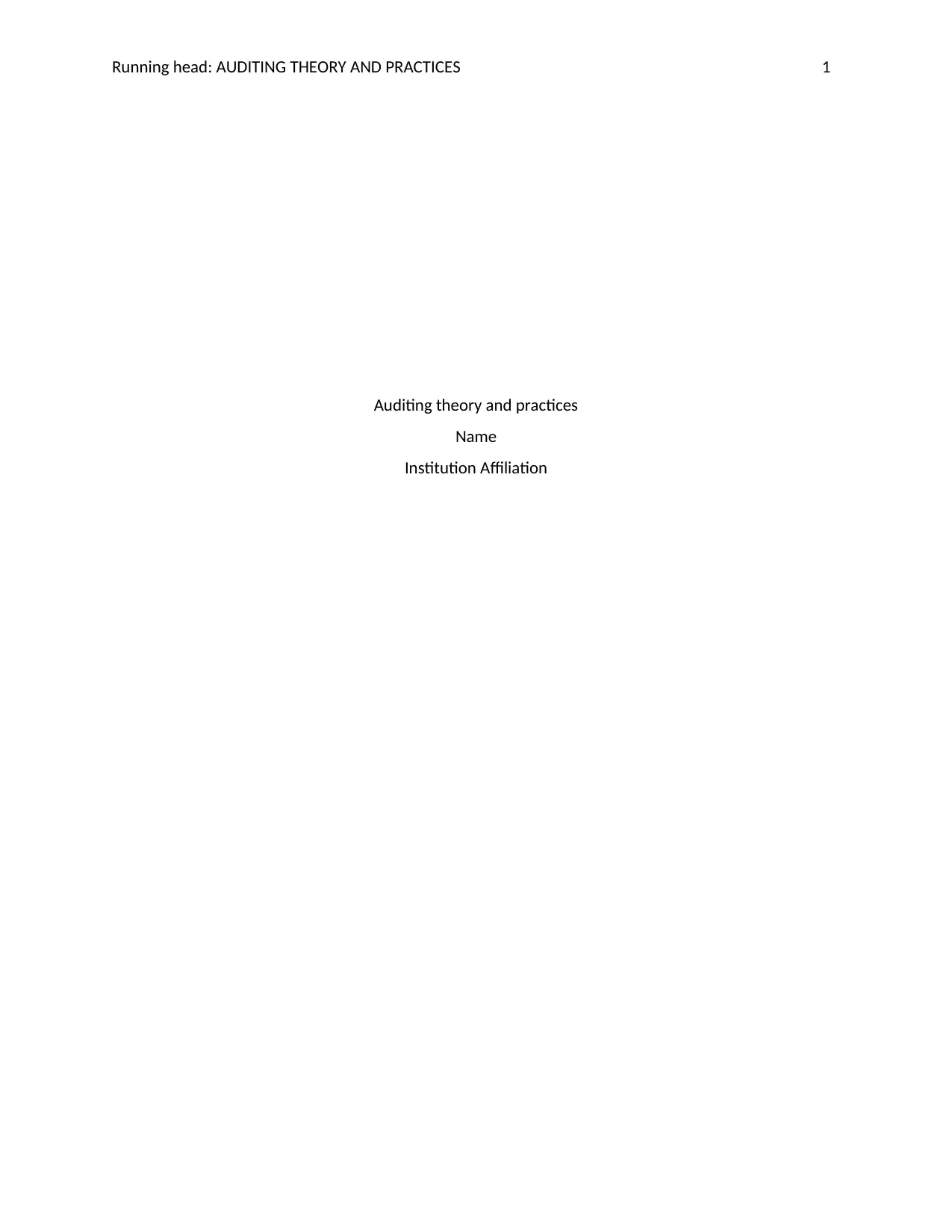
Running head: AUDITING THEORY AND PRACTICES 1
Auditing theory and practices
Name
Institution Affiliation
Auditing theory and practices
Name
Institution Affiliation
Paraphrase This Document
Need a fresh take? Get an instant paraphrase of this document with our AI Paraphraser
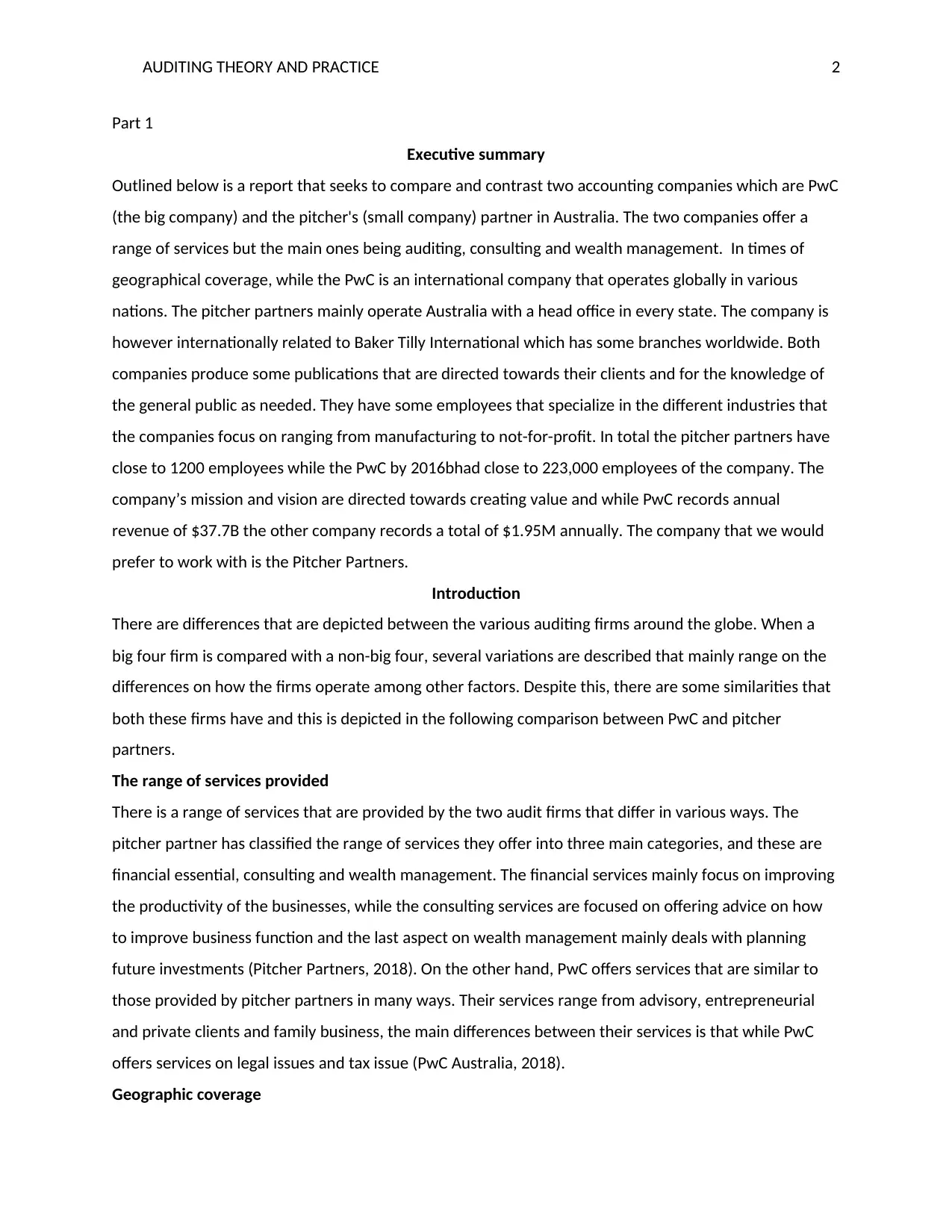
AUDITING THEORY AND PRACTICE 2
Part 1
Executive summary
Outlined below is a report that seeks to compare and contrast two accounting companies which are PwC
(the big company) and the pitcher's (small company) partner in Australia. The two companies offer a
range of services but the main ones being auditing, consulting and wealth management. In times of
geographical coverage, while the PwC is an international company that operates globally in various
nations. The pitcher partners mainly operate Australia with a head office in every state. The company is
however internationally related to Baker Tilly International which has some branches worldwide. Both
companies produce some publications that are directed towards their clients and for the knowledge of
the general public as needed. They have some employees that specialize in the different industries that
the companies focus on ranging from manufacturing to not-for-profit. In total the pitcher partners have
close to 1200 employees while the PwC by 2016bhad close to 223,000 employees of the company. The
company’s mission and vision are directed towards creating value and while PwC records annual
revenue of $37.7B the other company records a total of $1.95M annually. The company that we would
prefer to work with is the Pitcher Partners.
Introduction
There are differences that are depicted between the various auditing firms around the globe. When a
big four firm is compared with a non-big four, several variations are described that mainly range on the
differences on how the firms operate among other factors. Despite this, there are some similarities that
both these firms have and this is depicted in the following comparison between PwC and pitcher
partners.
The range of services provided
There is a range of services that are provided by the two audit firms that differ in various ways. The
pitcher partner has classified the range of services they offer into three main categories, and these are
financial essential, consulting and wealth management. The financial services mainly focus on improving
the productivity of the businesses, while the consulting services are focused on offering advice on how
to improve business function and the last aspect on wealth management mainly deals with planning
future investments (Pitcher Partners, 2018). On the other hand, PwC offers services that are similar to
those provided by pitcher partners in many ways. Their services range from advisory, entrepreneurial
and private clients and family business, the main differences between their services is that while PwC
offers services on legal issues and tax issue (PwC Australia, 2018).
Geographic coverage
Part 1
Executive summary
Outlined below is a report that seeks to compare and contrast two accounting companies which are PwC
(the big company) and the pitcher's (small company) partner in Australia. The two companies offer a
range of services but the main ones being auditing, consulting and wealth management. In times of
geographical coverage, while the PwC is an international company that operates globally in various
nations. The pitcher partners mainly operate Australia with a head office in every state. The company is
however internationally related to Baker Tilly International which has some branches worldwide. Both
companies produce some publications that are directed towards their clients and for the knowledge of
the general public as needed. They have some employees that specialize in the different industries that
the companies focus on ranging from manufacturing to not-for-profit. In total the pitcher partners have
close to 1200 employees while the PwC by 2016bhad close to 223,000 employees of the company. The
company’s mission and vision are directed towards creating value and while PwC records annual
revenue of $37.7B the other company records a total of $1.95M annually. The company that we would
prefer to work with is the Pitcher Partners.
Introduction
There are differences that are depicted between the various auditing firms around the globe. When a
big four firm is compared with a non-big four, several variations are described that mainly range on the
differences on how the firms operate among other factors. Despite this, there are some similarities that
both these firms have and this is depicted in the following comparison between PwC and pitcher
partners.
The range of services provided
There is a range of services that are provided by the two audit firms that differ in various ways. The
pitcher partner has classified the range of services they offer into three main categories, and these are
financial essential, consulting and wealth management. The financial services mainly focus on improving
the productivity of the businesses, while the consulting services are focused on offering advice on how
to improve business function and the last aspect on wealth management mainly deals with planning
future investments (Pitcher Partners, 2018). On the other hand, PwC offers services that are similar to
those provided by pitcher partners in many ways. Their services range from advisory, entrepreneurial
and private clients and family business, the main differences between their services is that while PwC
offers services on legal issues and tax issue (PwC Australia, 2018).
Geographic coverage
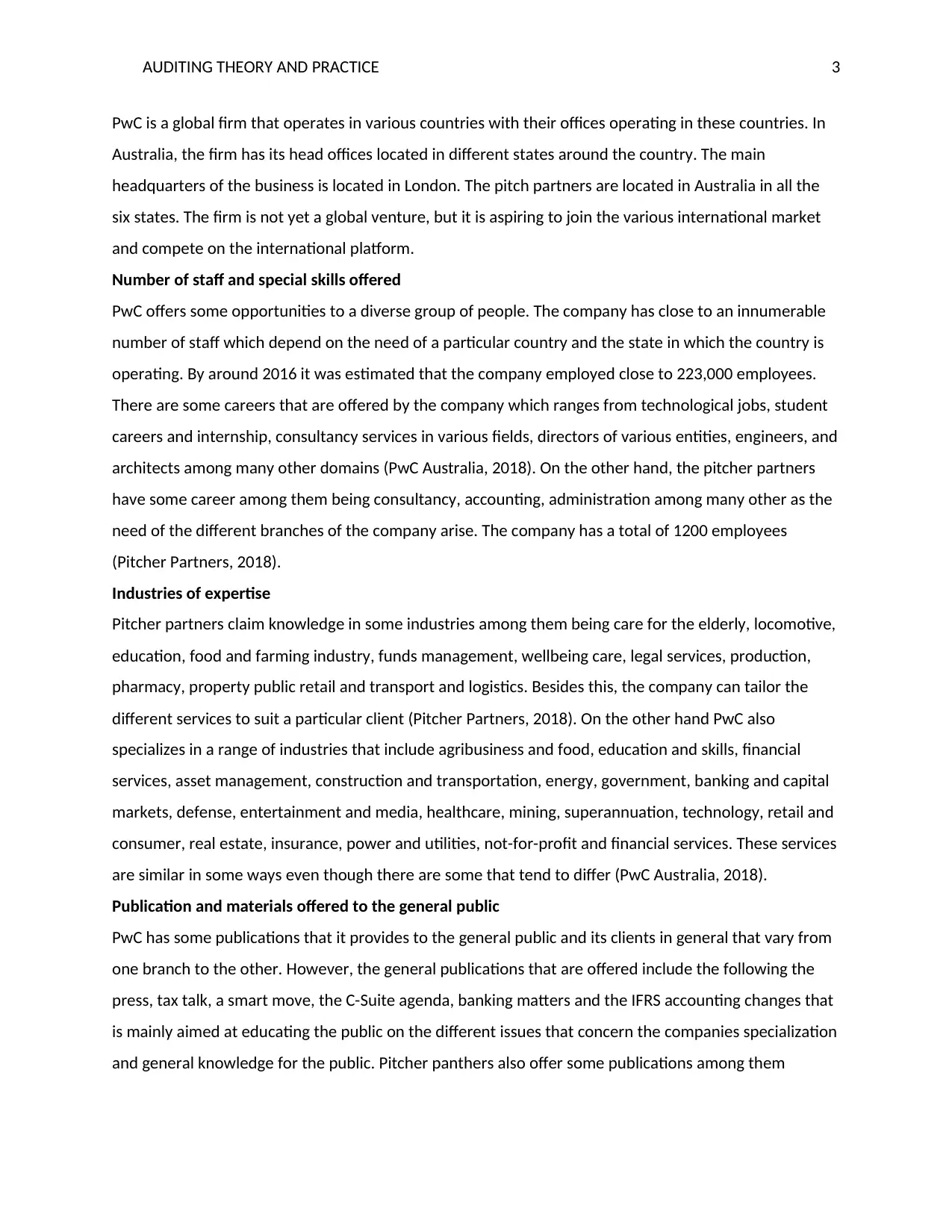
AUDITING THEORY AND PRACTICE 3
PwC is a global firm that operates in various countries with their offices operating in these countries. In
Australia, the firm has its head offices located in different states around the country. The main
headquarters of the business is located in London. The pitch partners are located in Australia in all the
six states. The firm is not yet a global venture, but it is aspiring to join the various international market
and compete on the international platform.
Number of staff and special skills offered
PwC offers some opportunities to a diverse group of people. The company has close to an innumerable
number of staff which depend on the need of a particular country and the state in which the country is
operating. By around 2016 it was estimated that the company employed close to 223,000 employees.
There are some careers that are offered by the company which ranges from technological jobs, student
careers and internship, consultancy services in various fields, directors of various entities, engineers, and
architects among many other domains (PwC Australia, 2018). On the other hand, the pitcher partners
have some career among them being consultancy, accounting, administration among many other as the
need of the different branches of the company arise. The company has a total of 1200 employees
(Pitcher Partners, 2018).
Industries of expertise
Pitcher partners claim knowledge in some industries among them being care for the elderly, locomotive,
education, food and farming industry, funds management, wellbeing care, legal services, production,
pharmacy, property public retail and transport and logistics. Besides this, the company can tailor the
different services to suit a particular client (Pitcher Partners, 2018). On the other hand PwC also
specializes in a range of industries that include agribusiness and food, education and skills, financial
services, asset management, construction and transportation, energy, government, banking and capital
markets, defense, entertainment and media, healthcare, mining, superannuation, technology, retail and
consumer, real estate, insurance, power and utilities, not-for-profit and financial services. These services
are similar in some ways even though there are some that tend to differ (PwC Australia, 2018).
Publication and materials offered to the general public
PwC has some publications that it provides to the general public and its clients in general that vary from
one branch to the other. However, the general publications that are offered include the following the
press, tax talk, a smart move, the C-Suite agenda, banking matters and the IFRS accounting changes that
is mainly aimed at educating the public on the different issues that concern the companies specialization
and general knowledge for the public. Pitcher panthers also offer some publications among them
PwC is a global firm that operates in various countries with their offices operating in these countries. In
Australia, the firm has its head offices located in different states around the country. The main
headquarters of the business is located in London. The pitch partners are located in Australia in all the
six states. The firm is not yet a global venture, but it is aspiring to join the various international market
and compete on the international platform.
Number of staff and special skills offered
PwC offers some opportunities to a diverse group of people. The company has close to an innumerable
number of staff which depend on the need of a particular country and the state in which the country is
operating. By around 2016 it was estimated that the company employed close to 223,000 employees.
There are some careers that are offered by the company which ranges from technological jobs, student
careers and internship, consultancy services in various fields, directors of various entities, engineers, and
architects among many other domains (PwC Australia, 2018). On the other hand, the pitcher partners
have some career among them being consultancy, accounting, administration among many other as the
need of the different branches of the company arise. The company has a total of 1200 employees
(Pitcher Partners, 2018).
Industries of expertise
Pitcher partners claim knowledge in some industries among them being care for the elderly, locomotive,
education, food and farming industry, funds management, wellbeing care, legal services, production,
pharmacy, property public retail and transport and logistics. Besides this, the company can tailor the
different services to suit a particular client (Pitcher Partners, 2018). On the other hand PwC also
specializes in a range of industries that include agribusiness and food, education and skills, financial
services, asset management, construction and transportation, energy, government, banking and capital
markets, defense, entertainment and media, healthcare, mining, superannuation, technology, retail and
consumer, real estate, insurance, power and utilities, not-for-profit and financial services. These services
are similar in some ways even though there are some that tend to differ (PwC Australia, 2018).
Publication and materials offered to the general public
PwC has some publications that it provides to the general public and its clients in general that vary from
one branch to the other. However, the general publications that are offered include the following the
press, tax talk, a smart move, the C-Suite agenda, banking matters and the IFRS accounting changes that
is mainly aimed at educating the public on the different issues that concern the companies specialization
and general knowledge for the public. Pitcher panthers also offer some publications among them
⊘ This is a preview!⊘
Do you want full access?
Subscribe today to unlock all pages.

Trusted by 1+ million students worldwide
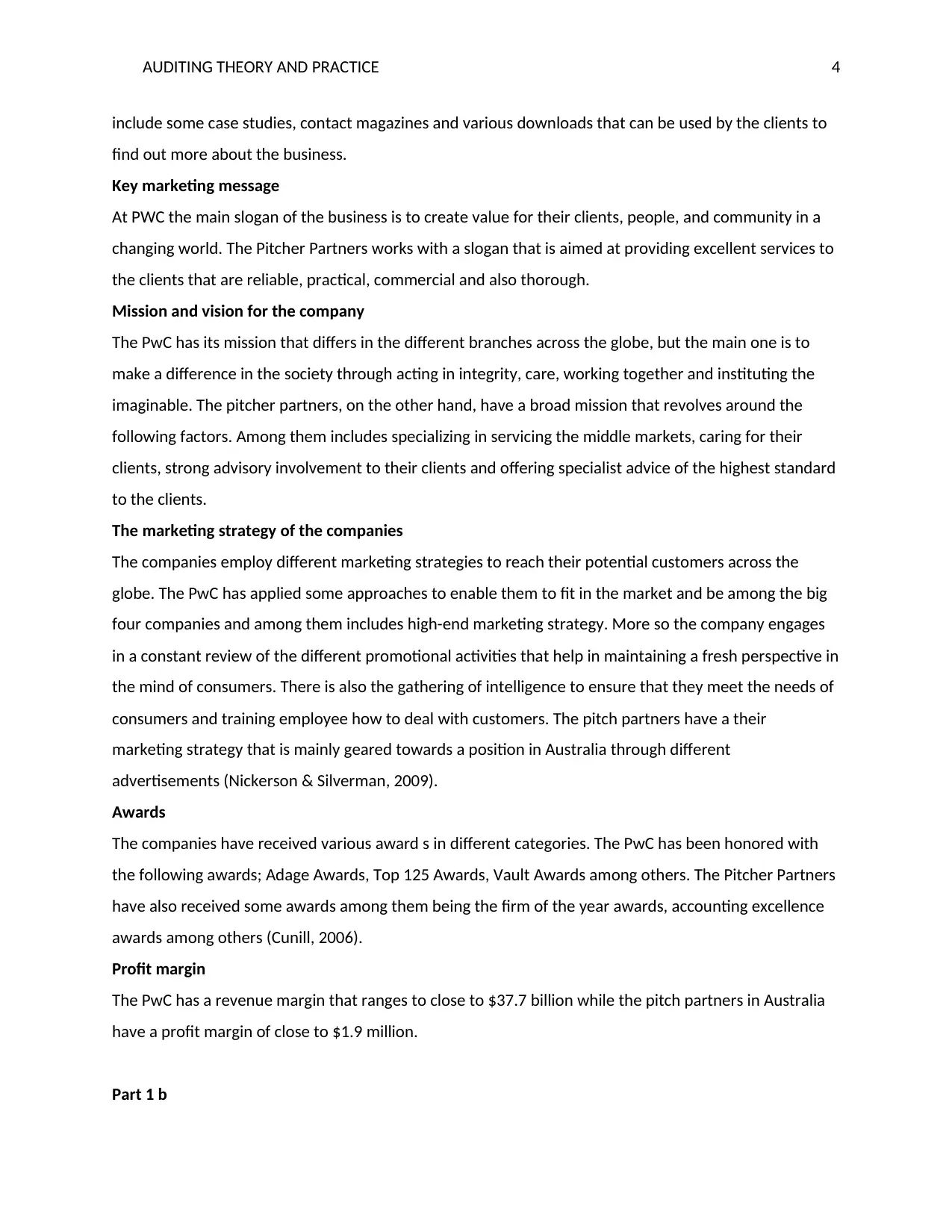
AUDITING THEORY AND PRACTICE 4
include some case studies, contact magazines and various downloads that can be used by the clients to
find out more about the business.
Key marketing message
At PWC the main slogan of the business is to create value for their clients, people, and community in a
changing world. The Pitcher Partners works with a slogan that is aimed at providing excellent services to
the clients that are reliable, practical, commercial and also thorough.
Mission and vision for the company
The PwC has its mission that differs in the different branches across the globe, but the main one is to
make a difference in the society through acting in integrity, care, working together and instituting the
imaginable. The pitcher partners, on the other hand, have a broad mission that revolves around the
following factors. Among them includes specializing in servicing the middle markets, caring for their
clients, strong advisory involvement to their clients and offering specialist advice of the highest standard
to the clients.
The marketing strategy of the companies
The companies employ different marketing strategies to reach their potential customers across the
globe. The PwC has applied some approaches to enable them to fit in the market and be among the big
four companies and among them includes high-end marketing strategy. More so the company engages
in a constant review of the different promotional activities that help in maintaining a fresh perspective in
the mind of consumers. There is also the gathering of intelligence to ensure that they meet the needs of
consumers and training employee how to deal with customers. The pitch partners have a their
marketing strategy that is mainly geared towards a position in Australia through different
advertisements (Nickerson & Silverman, 2009).
Awards
The companies have received various award s in different categories. The PwC has been honored with
the following awards; Adage Awards, Top 125 Awards, Vault Awards among others. The Pitcher Partners
have also received some awards among them being the firm of the year awards, accounting excellence
awards among others (Cunill, 2006).
Profit margin
The PwC has a revenue margin that ranges to close to $37.7 billion while the pitch partners in Australia
have a profit margin of close to $1.9 million.
Part 1 b
include some case studies, contact magazines and various downloads that can be used by the clients to
find out more about the business.
Key marketing message
At PWC the main slogan of the business is to create value for their clients, people, and community in a
changing world. The Pitcher Partners works with a slogan that is aimed at providing excellent services to
the clients that are reliable, practical, commercial and also thorough.
Mission and vision for the company
The PwC has its mission that differs in the different branches across the globe, but the main one is to
make a difference in the society through acting in integrity, care, working together and instituting the
imaginable. The pitcher partners, on the other hand, have a broad mission that revolves around the
following factors. Among them includes specializing in servicing the middle markets, caring for their
clients, strong advisory involvement to their clients and offering specialist advice of the highest standard
to the clients.
The marketing strategy of the companies
The companies employ different marketing strategies to reach their potential customers across the
globe. The PwC has applied some approaches to enable them to fit in the market and be among the big
four companies and among them includes high-end marketing strategy. More so the company engages
in a constant review of the different promotional activities that help in maintaining a fresh perspective in
the mind of consumers. There is also the gathering of intelligence to ensure that they meet the needs of
consumers and training employee how to deal with customers. The pitch partners have a their
marketing strategy that is mainly geared towards a position in Australia through different
advertisements (Nickerson & Silverman, 2009).
Awards
The companies have received various award s in different categories. The PwC has been honored with
the following awards; Adage Awards, Top 125 Awards, Vault Awards among others. The Pitcher Partners
have also received some awards among them being the firm of the year awards, accounting excellence
awards among others (Cunill, 2006).
Profit margin
The PwC has a revenue margin that ranges to close to $37.7 billion while the pitch partners in Australia
have a profit margin of close to $1.9 million.
Part 1 b
Paraphrase This Document
Need a fresh take? Get an instant paraphrase of this document with our AI Paraphraser
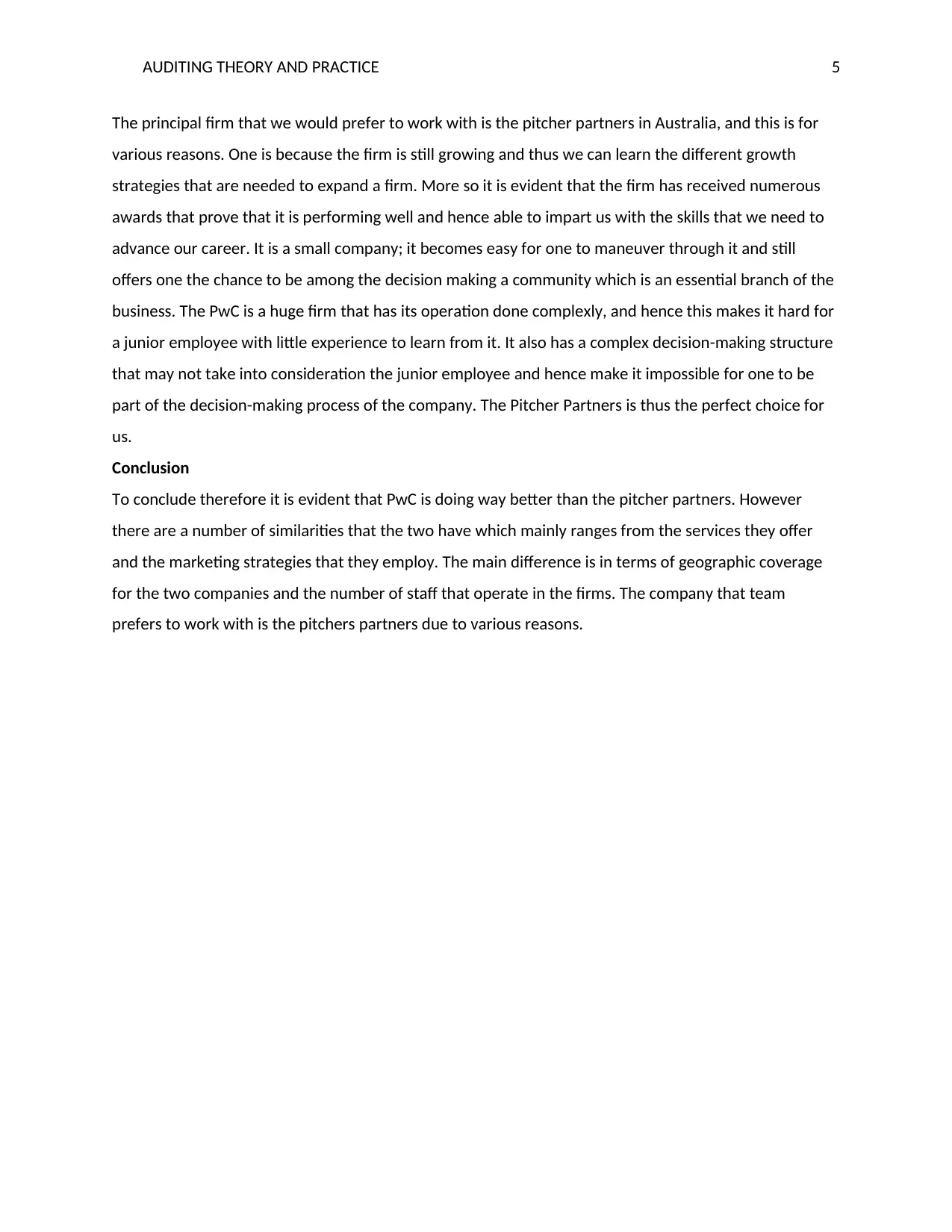
AUDITING THEORY AND PRACTICE 5
The principal firm that we would prefer to work with is the pitcher partners in Australia, and this is for
various reasons. One is because the firm is still growing and thus we can learn the different growth
strategies that are needed to expand a firm. More so it is evident that the firm has received numerous
awards that prove that it is performing well and hence able to impart us with the skills that we need to
advance our career. It is a small company; it becomes easy for one to maneuver through it and still
offers one the chance to be among the decision making a community which is an essential branch of the
business. The PwC is a huge firm that has its operation done complexly, and hence this makes it hard for
a junior employee with little experience to learn from it. It also has a complex decision-making structure
that may not take into consideration the junior employee and hence make it impossible for one to be
part of the decision-making process of the company. The Pitcher Partners is thus the perfect choice for
us.
Conclusion
To conclude therefore it is evident that PwC is doing way better than the pitcher partners. However
there are a number of similarities that the two have which mainly ranges from the services they offer
and the marketing strategies that they employ. The main difference is in terms of geographic coverage
for the two companies and the number of staff that operate in the firms. The company that team
prefers to work with is the pitchers partners due to various reasons.
The principal firm that we would prefer to work with is the pitcher partners in Australia, and this is for
various reasons. One is because the firm is still growing and thus we can learn the different growth
strategies that are needed to expand a firm. More so it is evident that the firm has received numerous
awards that prove that it is performing well and hence able to impart us with the skills that we need to
advance our career. It is a small company; it becomes easy for one to maneuver through it and still
offers one the chance to be among the decision making a community which is an essential branch of the
business. The PwC is a huge firm that has its operation done complexly, and hence this makes it hard for
a junior employee with little experience to learn from it. It also has a complex decision-making structure
that may not take into consideration the junior employee and hence make it impossible for one to be
part of the decision-making process of the company. The Pitcher Partners is thus the perfect choice for
us.
Conclusion
To conclude therefore it is evident that PwC is doing way better than the pitcher partners. However
there are a number of similarities that the two have which mainly ranges from the services they offer
and the marketing strategies that they employ. The main difference is in terms of geographic coverage
for the two companies and the number of staff that operate in the firms. The company that team
prefers to work with is the pitchers partners due to various reasons.
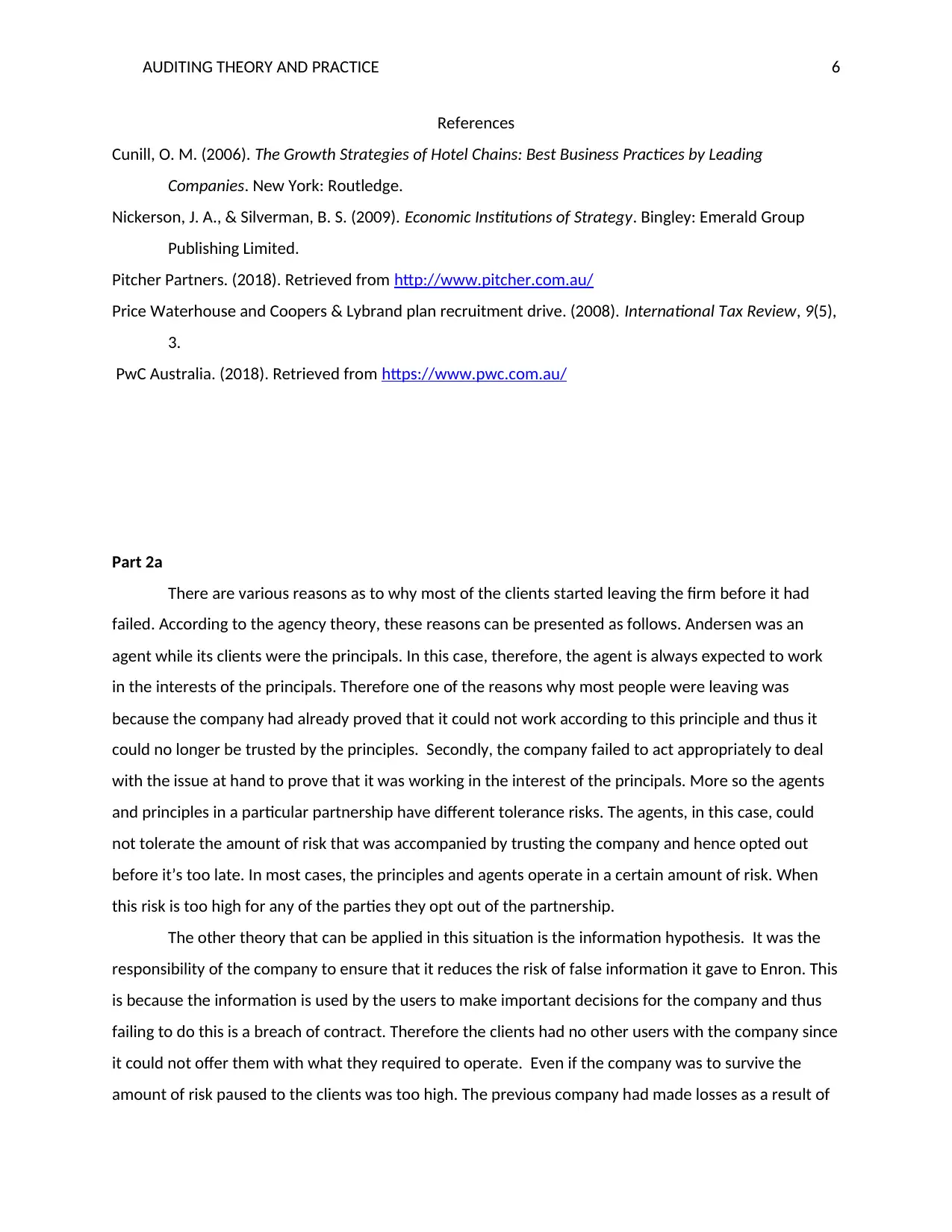
AUDITING THEORY AND PRACTICE 6
References
Cunill, O. M. (2006). The Growth Strategies of Hotel Chains: Best Business Practices by Leading
Companies. New York: Routledge.
Nickerson, J. A., & Silverman, B. S. (2009). Economic Institutions of Strategy. Bingley: Emerald Group
Publishing Limited.
Pitcher Partners. (2018). Retrieved from http://www.pitcher.com.au/
Price Waterhouse and Coopers & Lybrand plan recruitment drive. (2008). International Tax Review, 9(5),
3.
PwC Australia. (2018). Retrieved from https://www.pwc.com.au/
Part 2a
There are various reasons as to why most of the clients started leaving the firm before it had
failed. According to the agency theory, these reasons can be presented as follows. Andersen was an
agent while its clients were the principals. In this case, therefore, the agent is always expected to work
in the interests of the principals. Therefore one of the reasons why most people were leaving was
because the company had already proved that it could not work according to this principle and thus it
could no longer be trusted by the principles. Secondly, the company failed to act appropriately to deal
with the issue at hand to prove that it was working in the interest of the principals. More so the agents
and principles in a particular partnership have different tolerance risks. The agents, in this case, could
not tolerate the amount of risk that was accompanied by trusting the company and hence opted out
before it’s too late. In most cases, the principles and agents operate in a certain amount of risk. When
this risk is too high for any of the parties they opt out of the partnership.
The other theory that can be applied in this situation is the information hypothesis. It was the
responsibility of the company to ensure that it reduces the risk of false information it gave to Enron. This
is because the information is used by the users to make important decisions for the company and thus
failing to do this is a breach of contract. Therefore the clients had no other users with the company since
it could not offer them with what they required to operate. Even if the company was to survive the
amount of risk paused to the clients was too high. The previous company had made losses as a result of
References
Cunill, O. M. (2006). The Growth Strategies of Hotel Chains: Best Business Practices by Leading
Companies. New York: Routledge.
Nickerson, J. A., & Silverman, B. S. (2009). Economic Institutions of Strategy. Bingley: Emerald Group
Publishing Limited.
Pitcher Partners. (2018). Retrieved from http://www.pitcher.com.au/
Price Waterhouse and Coopers & Lybrand plan recruitment drive. (2008). International Tax Review, 9(5),
3.
PwC Australia. (2018). Retrieved from https://www.pwc.com.au/
Part 2a
There are various reasons as to why most of the clients started leaving the firm before it had
failed. According to the agency theory, these reasons can be presented as follows. Andersen was an
agent while its clients were the principals. In this case, therefore, the agent is always expected to work
in the interests of the principals. Therefore one of the reasons why most people were leaving was
because the company had already proved that it could not work according to this principle and thus it
could no longer be trusted by the principles. Secondly, the company failed to act appropriately to deal
with the issue at hand to prove that it was working in the interest of the principals. More so the agents
and principles in a particular partnership have different tolerance risks. The agents, in this case, could
not tolerate the amount of risk that was accompanied by trusting the company and hence opted out
before it’s too late. In most cases, the principles and agents operate in a certain amount of risk. When
this risk is too high for any of the parties they opt out of the partnership.
The other theory that can be applied in this situation is the information hypothesis. It was the
responsibility of the company to ensure that it reduces the risk of false information it gave to Enron. This
is because the information is used by the users to make important decisions for the company and thus
failing to do this is a breach of contract. Therefore the clients had no other users with the company since
it could not offer them with what they required to operate. Even if the company was to survive the
amount of risk paused to the clients was too high. The previous company had made losses as a result of
⊘ This is a preview!⊘
Do you want full access?
Subscribe today to unlock all pages.

Trusted by 1+ million students worldwide
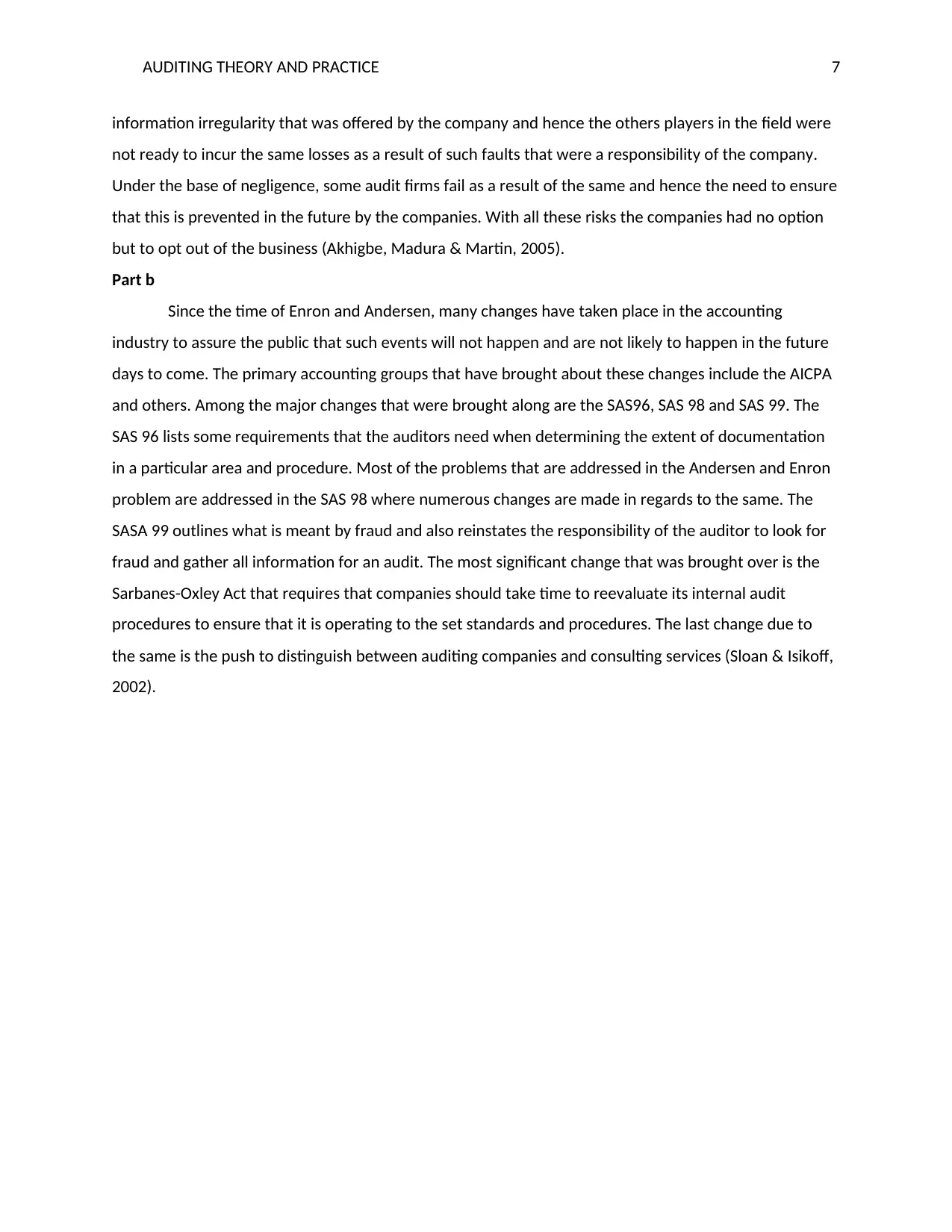
AUDITING THEORY AND PRACTICE 7
information irregularity that was offered by the company and hence the others players in the field were
not ready to incur the same losses as a result of such faults that were a responsibility of the company.
Under the base of negligence, some audit firms fail as a result of the same and hence the need to ensure
that this is prevented in the future by the companies. With all these risks the companies had no option
but to opt out of the business (Akhigbe, Madura & Martin, 2005).
Part b
Since the time of Enron and Andersen, many changes have taken place in the accounting
industry to assure the public that such events will not happen and are not likely to happen in the future
days to come. The primary accounting groups that have brought about these changes include the AICPA
and others. Among the major changes that were brought along are the SAS96, SAS 98 and SAS 99. The
SAS 96 lists some requirements that the auditors need when determining the extent of documentation
in a particular area and procedure. Most of the problems that are addressed in the Andersen and Enron
problem are addressed in the SAS 98 where numerous changes are made in regards to the same. The
SASA 99 outlines what is meant by fraud and also reinstates the responsibility of the auditor to look for
fraud and gather all information for an audit. The most significant change that was brought over is the
Sarbanes-Oxley Act that requires that companies should take time to reevaluate its internal audit
procedures to ensure that it is operating to the set standards and procedures. The last change due to
the same is the push to distinguish between auditing companies and consulting services (Sloan & Isikoff,
2002).
information irregularity that was offered by the company and hence the others players in the field were
not ready to incur the same losses as a result of such faults that were a responsibility of the company.
Under the base of negligence, some audit firms fail as a result of the same and hence the need to ensure
that this is prevented in the future by the companies. With all these risks the companies had no option
but to opt out of the business (Akhigbe, Madura & Martin, 2005).
Part b
Since the time of Enron and Andersen, many changes have taken place in the accounting
industry to assure the public that such events will not happen and are not likely to happen in the future
days to come. The primary accounting groups that have brought about these changes include the AICPA
and others. Among the major changes that were brought along are the SAS96, SAS 98 and SAS 99. The
SAS 96 lists some requirements that the auditors need when determining the extent of documentation
in a particular area and procedure. Most of the problems that are addressed in the Andersen and Enron
problem are addressed in the SAS 98 where numerous changes are made in regards to the same. The
SASA 99 outlines what is meant by fraud and also reinstates the responsibility of the auditor to look for
fraud and gather all information for an audit. The most significant change that was brought over is the
Sarbanes-Oxley Act that requires that companies should take time to reevaluate its internal audit
procedures to ensure that it is operating to the set standards and procedures. The last change due to
the same is the push to distinguish between auditing companies and consulting services (Sloan & Isikoff,
2002).
Paraphrase This Document
Need a fresh take? Get an instant paraphrase of this document with our AI Paraphraser

AUDITING THEORY AND PRACTICE 8
References
Akhigbe, A., Madura, J., & Martin, A. D. (2005). ACCOUNTING CONTAGION: THE CASE OF
ENRON. Journal Of Economics & Finance, 29(2), 187-202
Sloan, A., & Isikoff, M. (2002). The Enron Effect: As the accounting scandal spreads, regulators and
politicians are pounding the table for reform. But will anything really change?. Newsweek,
References
Akhigbe, A., Madura, J., & Martin, A. D. (2005). ACCOUNTING CONTAGION: THE CASE OF
ENRON. Journal Of Economics & Finance, 29(2), 187-202
Sloan, A., & Isikoff, M. (2002). The Enron Effect: As the accounting scandal spreads, regulators and
politicians are pounding the table for reform. But will anything really change?. Newsweek,
1 out of 8
Related Documents
Your All-in-One AI-Powered Toolkit for Academic Success.
+13062052269
info@desklib.com
Available 24*7 on WhatsApp / Email
![[object Object]](/_next/static/media/star-bottom.7253800d.svg)
Unlock your academic potential
Copyright © 2020–2025 A2Z Services. All Rights Reserved. Developed and managed by ZUCOL.





